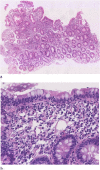Clinicopathologic features of Good's syndrome: Two cases and literature review
- PMID: 33851032
- PMCID: PMC8019250
- DOI: 10.1515/med-2021-0256
Clinicopathologic features of Good's syndrome: Two cases and literature review
Abstract
Background: Good's syndrome (GS) is an immunodeficiency disease, causing thymoma, low or absent B-cells, hypogammaglobulinemia, and defects in cell-mediated immunity. The most common clinical presentation is recurrent infection, followed by refractory diarrhea, due to the immunodeficiency. However, there are only few reports on intestinal endoscopy and pathology.
Case summary: We report here two typical GS cases with diarrhea as the prominent manifestation. Both cases presented with thymoma combined with immunodeficiency, characterized by hypogammaglobulinemia, low or absent B lymphocytes, and decreased T-cells with inverted CD4+/CD8+ T-cell ratio, while two GS patients were evaluated by endoscopy revealed mucosal edema and fine-granular or nodular appearance changes in the small intestine. Histological examination showed chronic inflammation and villous atrophy. A very interesting finding is that the inflammatory cell infiltration in the two GS cases was different. In one case, predominantly CD138+ plasma cells with only scattered CD3+ T-cells infiltration were revealed, while in another, it showed predominantly T-cells infiltration without plasma cells in the lamina propria. Although GS cases shared various clinical characteristics with common variable immunodeficiency (CVID) cases, they still differed from CVID cases in terms of its late onset, lack of familial clusters, low or absent peripheral blood B lymphocytes, absence of lymphoid hyperplasia, and plasma cells infiltration in the lamina propria in some patients. Although both patients had been diagnosed previously with recurrent diarrhea, respiratory infection, and thymoma, the association between these conditions and the possibility of GS was not recognized. The patients had remained misdiagnosed for 2 and 4 years, respectively, even after receiving the diagnosis of thymoma. The rarity of GS was likely the primary cause for the lack of disease recognition. Reporting of these cases will help to alert clinicians and raise awareness of this disease.
Conclusion: GS should be considered among the differential diagnoses for patients with unexplained recurrent diarrhea and opportunistic infection. Although it was regarded as a subset of CVID with thymoma, GS had a different clinical-pathological feature from CVID.
Keywords: Good’s syndrome; common variable immunodeficiency; diarrhea; immunodeficiency disease; opportunistic infection; thymoma.
© 2021 Yi-Dan Chen et al., published by De Gruyter.
Conflict of interest statement
Conflict of interest: The authors state no conflict of interest.
Figures








References
-
- Good RA, Varco RL. A clinical and experimental study of agammaglobulinemia. J Lancet. 1955;75(6):245–71. 10.1016/j.bbabio.2012.04.004. - DOI - PubMed
- Good RA, Varco RL. A clinical and experimental study of agammaglobulinemia. J Lancet. 1955;75(6):245–71. doi: 10.1016/j.bbabio.2012.04.004. - DOI - PubMed
-
- International Union of Immunological Societies. Primary immunodeficiency diseases. Report of an IUIS scientific committee. Clin Exp Immunol. 1999;118(Supp 1):1–28. 10.1046/j.1365-2249.1999.00109.x. - DOI - PMC - PubMed
- International Union of Immunological Societies. Primary immunodeficiency diseases. Report of an IUIS scientific committee. Clin Exp Immunol. 1999;118(Supp 1):1–28. doi: 10.1046/j.1365-2249.1999.00109.x. - DOI - PMC - PubMed
-
- Zaman M, Huissoon A, Buckland M, Patel S, Alachkar H, Edgar JD, et al. Clinical and laboratory features of seventy-eight UK patients with good’s syndrome (thymoma and hypogammaglobulinaemia). Clin Exp Immunol. 2019;1:132. 10.1111/cei.13216. - DOI - PMC - PubMed
- Zaman M, Huissoon A, Buckland M, Patel S, Alachkar H, Edgar JD. et al. Clinical and laboratory features of seventy-eight UK patients with good’s syndrome (thymoma and hypogammaglobulinaemia) Clin Exp Immunol. 2019;1:132. doi: 10.1111/cei.13216. - DOI - PMC - PubMed
-
- Kelesidis T, Yang O. Good’s syndrome remains a mystery after 55 years: a systematic review of the scientific evidence. Clin Immunol. 2010;135(3):347–63. 10.1016/j.clim.2010.01.006. - DOI - PMC - PubMed
- Kelesidis T, Yang O. Good’s syndrome remains a mystery after 55 years: a systematic review of the scientific evidence. Clin Immunol. 2010;135(3):347–63. doi: 10.1016/j.clim.2010.01.006. - DOI - PMC - PubMed
Publication types
LinkOut - more resources
Full Text Sources
Other Literature Sources
Research Materials
